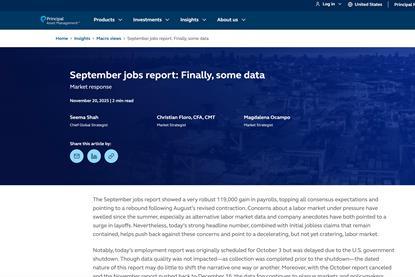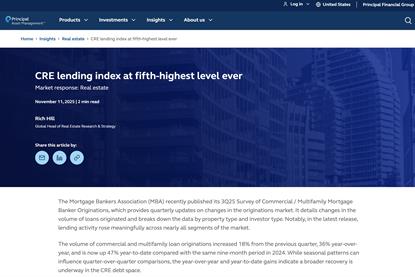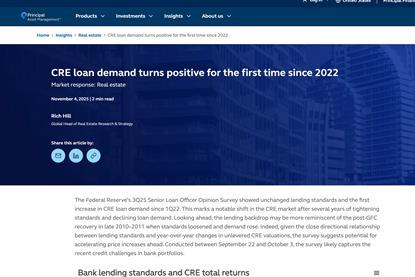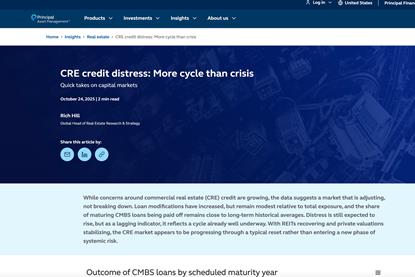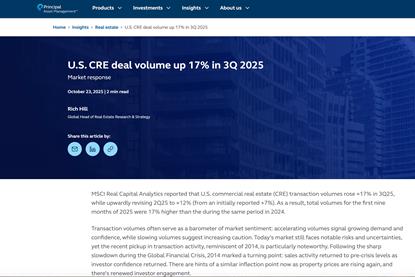Content (94)
-
White papers
September jobs report: Finally, some data
The report provides updated labour-market data (non-farm payrolls etc.) reflecting underlying economic and employment trends in the U.S., which have broader implications for CRE demand and overall real-estate fundamentals via consumption, income and employment stability
-
White papers
CRE lending index at fifth-highest level ever
The Mortgage Bankers Association (MBA) recently published its 3Q25 Survey of Commercial / Multifamily Mortgage Banker Originations, which provides quarterly updates on changes in the originations market. It details changes in the volume of loans originated and breaks down the data by property type and investor type. Notably, in the latest release, lending activity rose meaningfully across nearly all segments of the market. The volume of commercial and multifamily loan originations increased 18% from the previous quarter, 36% year-over-year, and is now up 47% year-to-date compared with the same nine-month period in 2024. While seasonal patterns can influence quarter-over-quarter comparisons, the year-over-year and year-to-date gains indicate a broader recovery is underway in the CRE debt space.
-
White papers
CRE loan demand turns positive for the first time since 2022
The average net share of CRE loan-demand respondents turned positive (+1.7%) in 3Q 2025 — the first positive reading since early 2022 — suggesting a possible shift in credit conditions that could support a broader CRE recovery.
-
White papers
America’s housing opportunity: Beyond the supply gap
Rentership remains a cornerstone at approximately 35% of U.S. households, the rental market goes well beyond apartments, and the central challenge is not only undersupply — but a mismatch between the types and locations of housing relative to where demand exists.
-
White papers
CRE credit distress: More cycle than crisis
This analysis argues that while stress in CRE credit markets has increased, the deterioration appears more cyclical than systemic — actual distress remains contained, supported by stable underwriting standards and resilience in core debt markets.
-
White papers
U.S. CRE deal volume up 17% in 3Q 2025
MSCI Real Capital Analytics reports that U.S. commercial real-estate (CRE) transaction volume increased by 17% in 3Q 2025, with volumes year-to-date through September up 17% compared with the same period in 2024 — signalling renewed investor demand and confidence across most property types.
-
White papers
What’s the Fed watching in CRE? (September Minutes Update)
U.S. commercial real estate remains under the Fed’s watch as delinquency rates rise in CMBS loans, but liquidity across CRE credit markets stays broadly stable, supported by disciplined lending and resilient fundamentals.
-
White papers
U.S. Commercial Real Estate Market Overview
The U.S. CRE market shows early signs of stabilization, with improving fundamentals and more balanced supply–demand dynamics after a period of repricing and tighter financing conditions.
-
White papers
Data center development opportunities in secondary markets
Secondary U.S. markets are emerging as key growth hubs for data centers, driven by strong digital infrastructure demand, power availability, and cost advantages over primary markets.
-
White papers
Why real estate credit amid continued trade policy uncertainty and U.S. debt concerns?
Real estate credit offers resilient income amid U.S. trade policy uncertainty and rising debt concerns, supported by floating rates, faster amortization, and equity cushions. Strong fundamentals in sectors like multifamily and industrial further reinforce its stability for investors.
-
White papers
U.S. CRE deal volume up 7% in 2Q 2025
U.S. CRE deal volume rose 7% in Q2 2025, driving a 13% year‑over‑year increase led by strong office, industrial, and retail activity.
-
White papers
The “One Big Beautiful Bill Act” and implications for commercial real estate
The “One Big Beautiful Bill Act” (OBBA), which was signed into law on July 4, 2025, preserves and, in many cases, strengthens the tax advantages of owning U.S. commercial real estate (CRE), both equity and debt. These provisions have the combined impact of lowering taxable income while increasing cash on cash returns and net operating cash flow. Additionally, section 899 (which was expected to have negative implications for foreign investment in the U.S., given its retaliatory tax measures) was removed from the final bill. Bottom line, the final bill is widely viewed to have net positive implications for the U.S. commercial real estate market.


